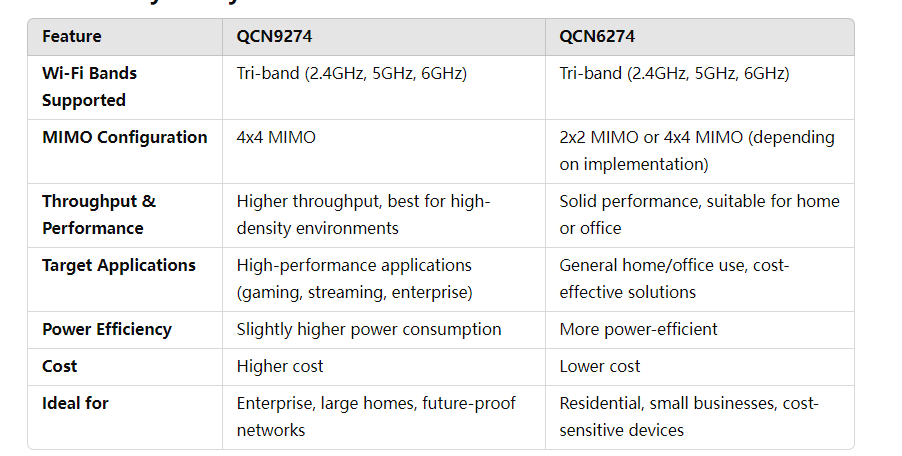Differences Between QCN9274 and QCN6274 Comprehensive Analysis
The QCN9274 and QCN6274 are both advanced Wi-Fi 7 (802.11be) chipsets developed by Qualcomm, offering state-of-the-art performance for next-generation wireless network adapters and access points. Although both are designed for high-performance wireless networks, they differ in key areas such as supported frequency bands, MIMO configurations, and specific use cases. In this article, we will explore these differences in detail to help you better understand their capabilities and ideal applications.
1. Wi-Fi Bands and Frequency Support
Both the QCN9274 and QCN6274 are designed to support three frequency bands (2.4GHz, 5GHz, and 6GHz), enabling them to take full advantage of Wi-Fi 7's potential. However, there are differences in how these chips are deployed and their impact on network performance.
QCN9274:Supports tri-band (2.4GHz, 5GHz, and 6GHz) connectivity, providing maximum flexibility and the ability to take full advantage of Wi-Fi 7’s advanced features, including ultra-wide channels and low latency across three bands. The 6GHz band is especially important for high-demand applications, such as 4K/8K video streaming, AR/VR, and low-latency gaming.
QCN6274:Also supports tri-band (2.4GHz, 5GHz, and 6GHz), which means it is similarly capable of leveraging the benefits of Wi-Fi 7's multi-band capabilities. This makes it an excellent choice for high-performance, multi-device networks where the 6GHz band can be used for high-speed, low-latency applications.
2. MIMO Configurations and Throughput
The MIMO (Multiple Input Multiple Output) technology is a crucial factor in the performance of Wi-Fi networks. The QCN9274 and QCN6274 support different MIMO configurations, which affect the data throughput and ability to handle multiple simultaneous users.
QCN9274:Supports 4x4 MIMO, which means it can handle four simultaneous streams for both upload and download data. This configuration allows for higher throughput, better network efficiency, and stronger support for dense environments with many connected devices.
QCN6274:Offers 2x2 MIMO as well as 4x4 MIMO configurations, depending on the implementation and the specific use case. The 4x4 configuration, like the QCN9274, provides enhanced performance, but in more cost-effective implementations, the 2x2 MIMO may be used, which is still highly capable but offers fewer simultaneous data streams.
3. Target Applications and Use Cases
Both the QCN9274 and QCN6274 are suitable for different deployment scenarios based on their performance characteristics.
QCN9274:
Ideal for high-performance applications that require full utilization of the 6GHz band and 4x4 MIMO. It is well-suited for enterprise networks, gaming, HD video streaming, and next-gen wireless experiences that demand low latency, high throughput, and support for many connected devices.
It’s perfect for large homes, public hotspots, and high-density environments, where having multiple devices connected at once is a norm.
QCN6274:
Also supports tri-band and 4x4 MIMO, making it a cost-effective option for high-performance networks. It is perfect for residential, small office, and medium-scale commercial networks where excellent throughput is needed but without the higher costs associated with the QCN9274.
The 4x4 MIMO configuration is particularly valuable for environments that require multiple simultaneous streams, such as offices with multiple connected devices or homes with several users streaming video or gaming.
4. Power Efficiency and Cost Considerations
While both chipsets offer excellent performance, there are differences in terms of power efficiency and cost.
QCN9274:
The more advanced feature set of the QCN9274—tri-band support, 4x4 MIMO, and future-proofing with the 6GHz band—may result in slightly higher power consumption and cost compared to the QCN6274.
It's better suited for high-end devices or enterprise applications where performance is the primary concern.
QCN6274:
The QCN6274 offers excellent performance at a more cost-effective price point. It is more power-efficient than the QCN9274 in certain configurations, especially when utilizing the 2x2 MIMO or lower throughput modes.
The cost savings make it an attractive option for consumer-grade devices or businesses looking for a solid but more affordable Wi-Fi 7 solution.
5. Compatibility and Integration
Both chipsets are compatible with existing Wi-Fi standards, including Wi-Fi 6 (802.11ax), which ensures backward compatibility with older devices. However, their support for newer technologies like Wi-Fi 7 can enhance the future-proofing of devices.
QCN9274:
With its tri-band, 4x4 MIMO, and 6GHz support, the QCN9274 is more geared toward next-generation applications and provides a more forward-looking solution for future wireless needs.
QCN6274:
While it also supports Wi-Fi 7 and tri-band connectivity, the QCN6274 may be more aligned with current and near-future network needs where the extra 6GHz capacity is not always necessary, but solid performance and multi-band capability are still required.
6. Summary of Key Differences

Conclusion
Both the QCN9274 and QCN6274 are high-performance Wi-Fi 7 chipsets capable of supporting tri-band connectivity and 4x4 MIMO configurations, making them suitable for next-generation wireless devices. The QCN9274 is designed for users who need top-tier performance, especially for demanding applications like gaming, HD video streaming, and high-density environments. Meanwhile, the QCN6274 offers a more cost-effective solution with comparable performance, making it ideal for residential, small office, and medium-scale commercial applications. Depending on the performance needs and budget, either chipset could be an excellent choice for your Wi-Fi 7-enabled devices.










评论